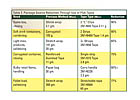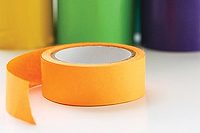
Environmental issues affect the packaging industry in two broad areas. The first is related to environmental stresses - both real and perceived - caused by the manufacture of packaging materials. The second relates to environmental stresses resulting from the distribution, use and final disposal of the package itself.
Regulations concerning the former category are fairly well established and understood. The latter category, however, has only recently received attention through regulation. One packaging segment that plays a major role in this category is the use of pressure-sensitive adhesive tapes for closure, sealing, reinforcement, bundling and unitizing.
Political Considerations
Scientists, engineers and other technologists are often dismayed when first introduced to environmental concerns in the course of their professional activities. Whereas in most scientific or engineering problems there are defined hypotheses or design goals that have an objective and scientific basis, regulations and guidelines often seem subjective, arbitrary, and sometimes vague.This dichotomy cannot be understood until one central fact is realized: environmental concerns are frequently politically motivated. Regulations evolve from the political process entailing the usual range of competing interests and beliefs. Various organizations and political lobbyists all seek to influence the political process. Add to this manufacturers and academics, as well as celebrities and apocalyptics, and the stage is set for a confusing debate that can obscure real and substantial environmental problems and lead to inefficient, counterproductive legislation.
Generally, environmental regulations seek to control emissions to air, water and land. Emissions include materials and energy in various forms. Specifically, the emphasis has been on emissions proven or considered to be harmful to the ecology, including several heavy metals.
P-S Tape Process
Environmental regulations affect pressure-sensitive tape technology in two key areas: manufacturing processes and product design. Such tapes usually consist of two major components: a backing and a pressure-sensitive adhesive. The backing may be paper, cloth, plastic, film, foil, laminate or another relatively flexible sheet material. One or both of the sides of the backing may be specially treated to provide controlled release or adhesion. The adhesive is coated on the backing and bonds to the target object as a result of the application of pressure.PSAs include a variety of natural and synthetic materials, including natural rubber, synthetic rubber, block copolymers, acrylics, silicones, etc., modified in various ways through molecular weight selection, tackifier resin addition, oils, fillers, crosslinking agents, stabilizers, pigments and other additives.
The majority of today's pressure-sensitive tapes consist of plastic film backing coated with natural rubber, synthetic rubber or acrylic PSA. Polypropylene, polyester and polyvinyl chloride constitute most of the films currently used. These films are normally formed by extrusion and do not require the use of solvents in forming the film. Historically, some film materials were cast from solvents, but these are the exception today rather than the rule.
Environmental concerns related to film manufacturing are minimal. Such concerns attending the manufacture of the various adhesive components are somewhat more complex but are considered more a part of the plastics, rubber and chemical industries rather than the pressure-sensitive tape industry.
The major environmental considerations result from the formation of the adhesive layer on the backing. The earliest PSAs, such as low-viscosity natural rubbers and rosins, were coated from solvent, including aliphatic hydrocarbons, toluene, and xylene. Without containment devices, these were simply exhausted into the atmosphere. Likewise, the production of energy to evaporate these solvents usually requires other emissions into the atmosphere, primarily carbon dioxide.
Over the past three decades, regulations in industrialized nations have increasingly restricted the quantity and types of emissions from such processes, particularly airborne emissions of photochemically active solvents. The regulations attempt to accommodate obsolete manufacturing processes through the use of improved control technologies.
A consequence of the increasingly restrictive emission regulations has been the parallel development of "pollution prevention" strategies and policies. Central to these strategies is the adoption of low- or non-polluting processes. Hence the growth of hot-melt pressure-sensitive adhesives (HM PSAs) based on block copolymers such as styrene-isoprene-styrene over the past two decades. Requiring no solvent and using minimal energy, these processes comply with tighter restrictions. Likewise, waterborne acrylate adhesive technologies have increased.
However, shortcomings in low-emission adhesive technologies, such as application temperature restriction in the case of HM PSAs and relatively low holding power (shear adhesion) in the case of waterborne acrylates, have led to new families of additives and processes designed to overcome such weaknesses. A recent example is UV crosslinkable acrylate.1 Low-pollution technology has become a major technical priority within the pressure-sensitive tape industry, even among suppliers.

Dealing with Solid Waste
As municipal solid waste (MSW) has overtaxed landfill and incineration facilities in the more populous industrial nations, environmental regulations aimed at minimizing MSW have affected packaging, including PSA tapes as components of packages. Historically, the emphasis has been on controlling emissions from the manufacturing process with little attention paid to the disposal of products.This has changed over the past decade, and particularly the past five years. Though packaging constitutes a relatively small portion of total MSW, its visibility makes it a convenient target for environmentalists. Likewise, although pressure-sensitive tapes constitute less than 0.01% by weight of the total MSW stream in the United States, their visibility in consumer and transport packaging makes them an easy target.
Opponents of landfilling MSW argue it is no longer a viable method of disposal, despite objective counterclaims by others.2 Opponents of incineration or waste-to-energy (incineration with energy recovery through electric power generation) are concerned about atmospheric emissions, including heavy metals, dioxin, acids and so-called greenhouse gasses.
The dioxin issue in particular has caused problems for a range of products containing polyvinyl chloride (PVC). The concern with dioxin emissions is based on a flawed Danish study, which was later refuted.3 Dioxin is not produced if incinerators or waste-to-energy facilities are run at proper temperatures. Moreover, dioxin emissions will result from any low-temperature combustion process involving organic matter in the presence of chlorine from a source such as sodium chloride.
Despite these scientific facts, PVC packaging tape volume in Europe decreased during the past year by 7.6%, while biaxially oriented polypropylene (BOPP) packaging tape volume increased by 36.6%.
A recent proposal for closed loop recycling of PVC would presumably meet objections to its usage in a range of products.4 However, MSW problems go beyond recycling. Recycling makes sense only if a net gain in resources is achieved after the separation, collection, transportation and reprocessing of used materials is completed and that net gain outweighs that of using new materials.
Guidelines from both the Coalition of Northeastern Governors (CONEG) and the Environmental Protection Agency (EPA) outline the desirability of package source reduction as a primary vehicle for MSW reduction in packaging. These general guidelines, as well as those generated by the Institute of Packing Professional (IoPP), were embodied in ASTM D 1974-92, Standard Practice for Methods Of Closing, Sealing and Reinforcing Fiberboard Shipping Containers.

An example of an application of this theory was demonstrated in a comparison of polystyrene to paper beverage containers for single use.5 The comparison revealed that, contrary to the perception paper drink containers are environmentally friendly (at least on a comparative basis), the production, use and disposal/recycling of the paper container required more energy and produced 2.5 times more emissions than the plastic container's life cycle.
A significant advantage of pressure-sensitive tape for packaging is shown in Tables 1-2. Table 1 shows the comparative source reduction advantage that PSA box sealing tapes have over alternative carton closure methods. Table 2 reveals the use of six different PSA products as replacements for alternative packaging techniques in a number of applications. The source reduction is significant, ranging from 75-98%.
Recycling of Corrugated
Although MSW reduction exclusively through the use of recycling has been shown to be flawed, the German "Verpackungsverordnung" (packaging ordinance) of June 12, 1991, obligated manufacturers and suppliers to reclaim used shipping containers and either reuse them or transmit them for recycling rather than discard them through public waste collection. This has caused a number of problems, including charges from other nations that the regulation is a non-tariff barrier to trade, and has resulted in export of scrap from Germany to other countries.Recycling, however, has been effective when it comes to corrugated transport packaging materials. Currently in the United States such materials are recycled at about a 50% rate, while Germany recycles approximately 80%. A major concern has been whether or not products used along with the corrugated containers interfere with the recycling process. One such concern is the presence of "stickies," which are small particles of resins, waxes, adhesives and other extraneous material that detract from output product quality.
The organization responsible for corrugated recycling in Germany, RESY, published standards for packaging aids in January 1992. They said of PSA box-sealing tapes: "Adhesive tape and stick-on labels are packaging aids that are not supposed to hinder the recycling process. This requirement is met when they disintegrate as little as possible in the slushing phase and can already be completely - which means both the adhesive materials as well as the bearing material (plastic or paper) - separated in the pulper or in the following sorting phase." In other words, if the adhesive remains with the backing scrap through normal separating processes and will not contribute to the "stickies."
Studies conducted on BOPP box-sealing tapes indicate the same is true with BOPP box-sealing tapes utilizing block copolymer adhesives.6,7 This work was substantiated at PTS Munich,8 where such tapes were described as "recycling oriented." Independent analysis of wastewater streams from industrial scale repulping processes revealed that SIS block copolymer from 3M tapes was not present.
One material known to cause "stickies" is hot-melt box closure adhesives, as described by Rose, who states that "recycling companies experience extreme and complex problems due to residual adhesive material in the package. Hot-melt adhesives are very difficult to remove from the recycling process. Residual hot melt will discolor the recycled resin and mar the recycled paperboard, limiting its marketability and reducing its value."9 The problem with these hot-melt adhesives is that they are not anchored to a backing, unlike hot-melt pressure sensitives, which are anchored to tape backings.
Even though the HM PSAs described do not contribute to the "stickies" in the repulping process, the tape scrap is removed and disposed of. Currently, this small quantity is landfilled or incinerated. The German government originally backed away from the use of incineration as a means of MSW disposal. While it permitted incineration of residue from recycling processes, it did not favor waste-to-energy as a form of recycling.
This has changed recently. Since July 1994, German law has permitted energy recovery from waste at a 75% recovery level. Since steam-powered generating plants operate at no more than 35-40% efficiency, energy-to-waste is restricted to gasification, heating of cement kilns and for fuel and steel factories.
Conclusion
The value or economic utility of pressure-sensitive tapes lies in their ability to accomplish a variety of tasks simply and economically. The alternative to the use of a pressure-sensitive tape product often entails greater cost, more material and increased environmental stress.For more information on recycling tape, contact 3M at http://www.mmm.com .
This article is based on a technical note from the Pressure Sensitive Tape Council. For more information, visit the PSTC website at http://www.pstc.org .
Links


